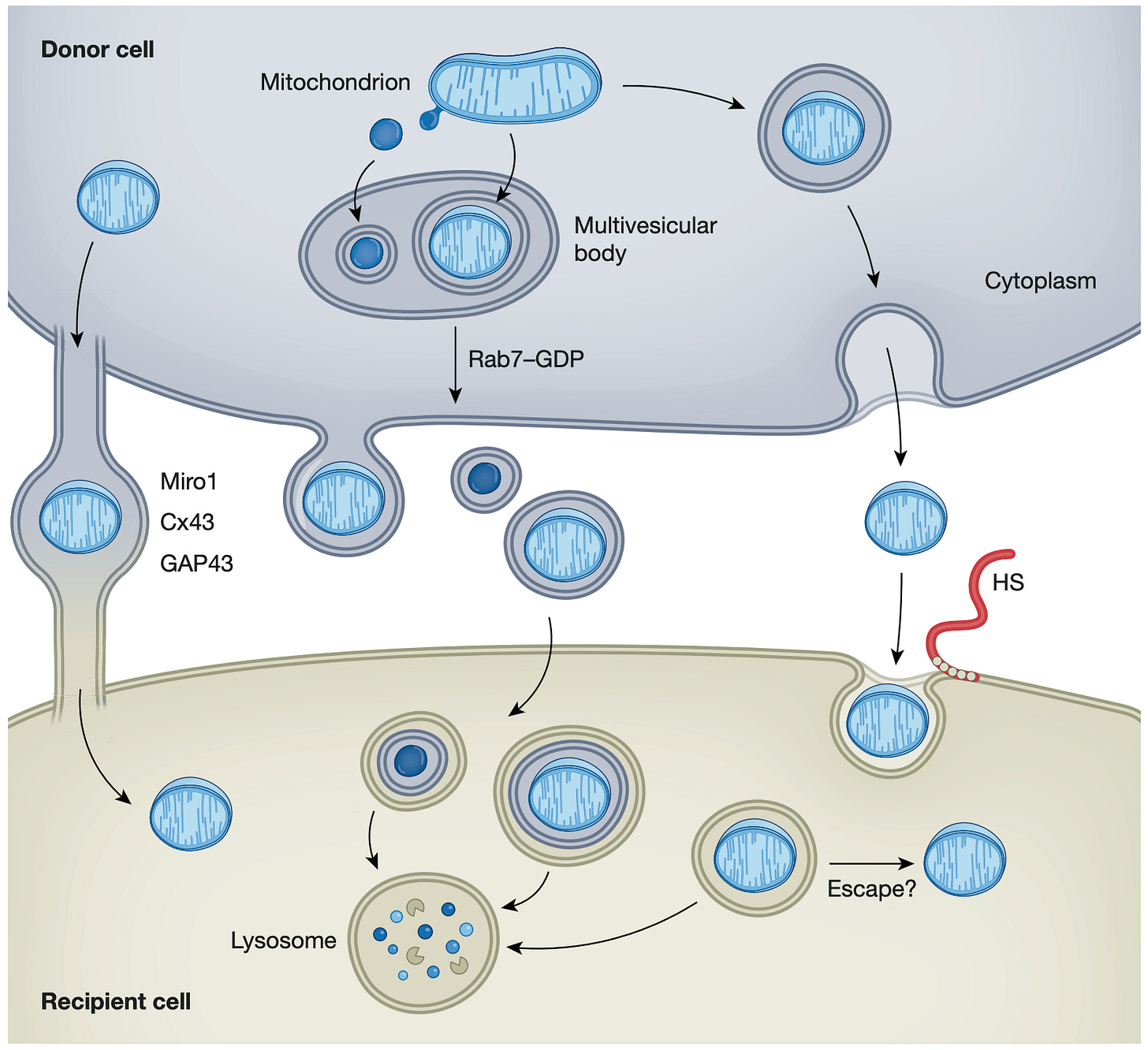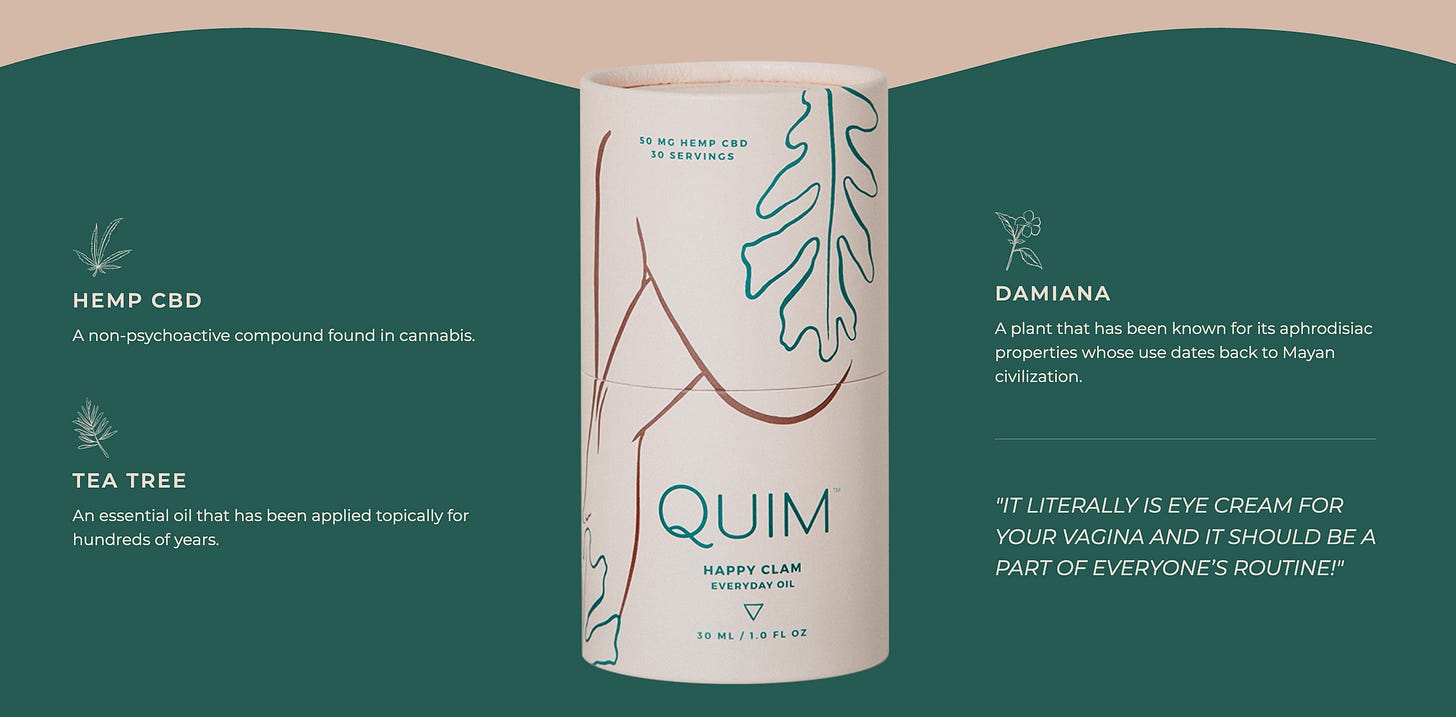>FASTA_11
Mitotherapies, GLP-1 as a band-aid, Doudna's mini CRISPR for plants, plant-based vaginal optimization, and Sperm racing marks the beginning of bioSports
Mitotherapies!
How often do you think of the mitochondrial empire? Did you know that aerobic exercise promotes mitochondrial replication? My bestie David Friedberg, also told me mitochondria can be transferred from one cell to another through transient cellular connections, extracellular vesicles, or releasing them to outer (extracellular) space for capture. Apparently, this process is involved in cancer, wound healing, cartilage regeneration, memory loss, and many other conditions, which means… mitochondria could become our new medicine?!
Akin to how insulin supply once depended on pigs, mitochondrial transplantation used to be limited by the availability of healthy mitochondria (109 mitochondria injection/patient) in human liver and muscle tissues. Instead, Chinese researchers just managed to use mesenchymal stem cells (MSCs) as mitochondria factories. Their innovation lies in an optimized culture medium that honed in a balance between cell proliferation and mitobiogenesis, resulting in a 854x increase in mitochondria production and a 5.7x increase in ATP production within 15 days.
You should care because mitotherapy can significantly regenerate osteoarthritic mice in 12 weeks. Also, because in epithelial wounds, platelet mitochondria are released in the extracellular space and bind to the surface of neutrophils, driving an antimicrobial inflammatory response. Want more? Cancer cells obtain mitochondria from T cells and macrophages, impairing antitumor immunity and driving cancer cells proliferation. MSCs also transfer mitochondria to T cells, inhibiting inflammatory cytokine production, limiting joint damage in arthritis.
GLP-1 as a band-aid
I’m coming from a very personal point of view that every benefit has a cost (e.g. you reject some dopamine when choosing to eat an apple instead of a doughnut). The fact that GLP-1 drugs block certain cravings, but those come back (together with the weight) when you abandon the treatment, bugs me to my bones. I worry something will go very wrong as we mess with our reward systems like that.
An 8-year study with 162,253 case and control patients, that excludes people with a history of major depression, found that patients on GLP-1 drugs exhibited a 195% higher risk of major depression, particularly intensified with prolonged exposure. Others have reported similar anecdotal experiences as soon as 1 month after taking semaglutide.
In the words of Tony Goldstone, brain sciences professor at Imperial College London, “the brain doesn’t have an ‘addiction to bad things’ circuit. We have reward systems that were developed to help us get food, water, salt and sex”. At the same time, he highlights that people on ozempic-like drugs still enjoy food, just less of it, so this could mean that pleasure and motivation may operate through slightly separate circuits.
I’ve struggled with overweight for the best part of my teens and now into my twenties. I know how much it sucks to hate what you see in the mirror, and how hard it is to control emotional eating. I’ve also learned though, that my craving is not the root cause. Whatever I’m seeking an escape from is. Our sedentary-first lifestyles, burnout societies, and fucked up food systems are the root causes — My somewhat contrarian idea, then, is that obesity is a systemic problem, and GLP-1 drugs are only a temporal band-aid.
Mini CRISPR for plants by Doudna & Banfield
To make a GMO plant, you usually need to use Agrobacterium. Since its infection isn’t uniform across all cells, tissue culture is used to select the edited cells and regenerate them into a whole plant from which to get seeds (a lengthy and labor-intensive process). Additionally, Agro will randomly integrate your DNA construct into the plant’s genome (ugh, mutations and transgenic labels). Though the floral dip method edits ovules to grow into edited seeds, this hasn’t proven useful for plants unlike Arabidopsis, and it still requires DNA integration.
This paper presents heritable, transgene-free plant genome editing using ISYmu1, a ~400-a.a RNA-guided enzyme, that fits into the tobacco rattle virus delivery, which works on over 400 plant species and can reach reproductive cells. Though this still requires an “agroflood” to infect the cells with the viral RNA, no DNA integration is required once viral replication and infection begins.
Editing efficiency was further enhanced by including an HDV ribozyme (cleaves the gRNA from the rest of the transcript), tRNAIleu (promotes TRV movement and transmission of edited alleles to the next generation), and heat shocking (improves viral replication).
Plant-based vaginal optimization
While sexual health talk has mainly focused on disease prevention, today’s generations want science-driven optimization. Personal lubricants are a low-hanging fruit with a USD 1.46 billion market. Today, many of these products contain spermicides that can disrupt the vaginal epithelial cell barrier (first line of defense in the vaginal mucosa), generate fertile ground for the growth of pathogenic strains like E. coli, or increase risk of infection by irritating the skin.
Brands like Quim are building a value proposal around the use of plant-based, CBD-infused (up to 100 mg/30 mL) and latex-friendly ingredients, coupled to copy that is very of-the-moment: use aloe-based Smooth Operator before your sexy time; and Happy Clam “vagina eye creme” anytime (after bathing, before bed, after sex, when PMSing or menstruating, postpartum).
Before cutting-edge science, consumer bioproducts like this can leverage scientific insights to define a niche market — If GenZ is having less sex than other generations, could their 50-year-old counterparts find these cannabis-infused intimacy oils more intriguing, given the decreasing libido that accompanies menopause?
Sex biotech not only has the potential to prevent disease and spark revolutions; it can literally change the course of humanity by changing the way we reproduce. Not unlike other areas of science, but particularly so because of the longstanding taboos around it, the science required to create new sex biotech depends on timely change of social ideologies, and their understanding.
Sperm racing marks the beginning of bioSports
To start off, Sperm Racing is not only an event but a male fertility company with $1M in funding. Jibby Kadri, CTO and friend of mine, shared that the event is a way to raise awareness about the male fertility crisis among young men, in a funny and entertaining way. Through this, they can build distribution for products like at-home sperm health kits and have users upload their data onto leaderboards for further competition. Their website envisions a day when sperm racing can be someone’s “full time career”.
Is this literal? Just as much as you’d imagine: the arena is a microfluidic chip that mimics the female reproductive tract, with two separate curved channels that act like tracks through which a few sperm ‘swim’ as fast as possible, pushed by a liquid current that includes chemical signals. That chip was put under a microscope and a camera that televised the 90-second event onto a huge screen for 5,000 attendees in LA and millions of viewers online. Some of them accrued $300K in total wagered via Polymarket. Check out this tweet storm on how they built it.
This is only the beginning of bioSports. In the F1 of biotech, millions (perhaps billions) will be gambled, sponsored, invested, and won. Individuals ranging from random college students to celebrities will become entrepreneurs of their biology. Biotechs will sponsor them and engineer them like race cars. In ephemeral moments, we will stream the collapse of the limits of biology as we know it.
Note the capitalistic and patriarchal hints: the notion that male value lies in virility and potency, the idea that male biology is more worthy of attention and innovation than the already-much-disregarded female biology, the ignorance of reproduction as a collaborative game between the male and the female, the attention diverted from the ecological (e.g. microplastics) causes of such fertility crisis — Once sacred, conception, may in fact (as Huxley envisioned) become mechanistic and as cheap as a TikTok video.
Girls, if there are good reasons to sperm race, there are good reasons to ovule rave (branding in progress, lol). Our yin counterpart should emphasize the role of networks (cervical mucus, uterine contractions, egg signals, vaginal microbes) in guiding fertilization. It should be a festival that blends ecological storytelling, indigenous reproductive knowledge, rituals… wanna grow it together?








